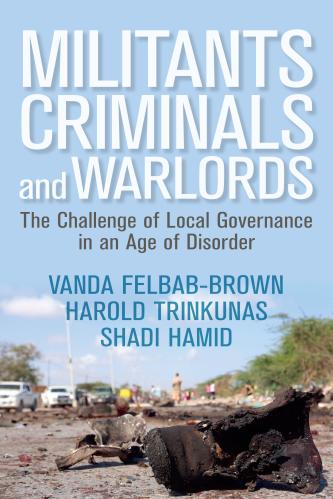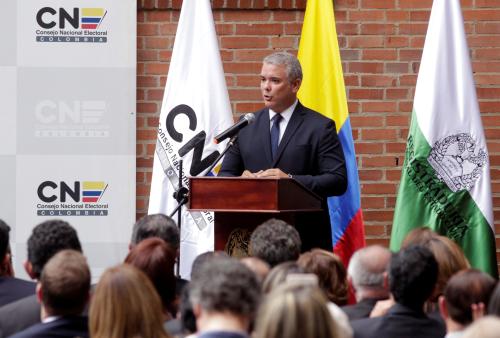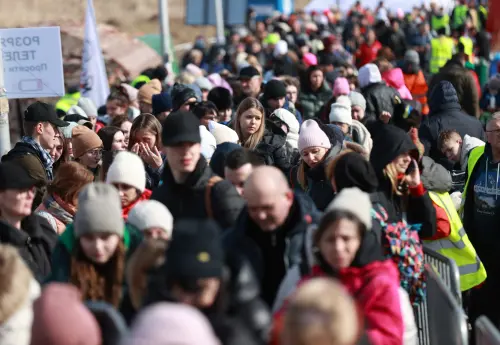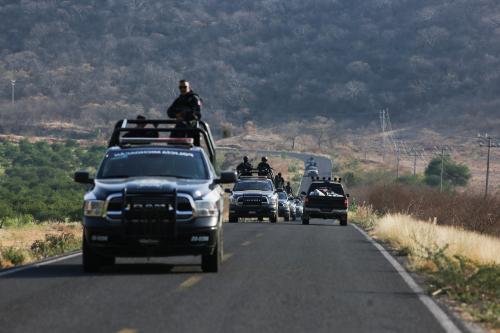Support for this publication was generously provided in part by the United States Department of Defense-Minerva Research Initiative. The views expressed are the author’s alone, consistent with Brookings’s commitment to independent research.
The June 2018 U.S. assessment that coca cultivation in Colombia increased again in 2017 has renewed pressures from Washington on Bogotá to intensify coca crop eradication. But the drones that President-elect Iván Duque considers to deploy to do the job provide only a mirage of greater effectiveness.
Sprouting Up and Thriving
According to the Office of National Drug Control Policy, in 2017 coca cultivation in Colombia expanded for a fourth consecutive year, this time by 11 percent to 209,000 hectares (ha) under cultivation. The expansion has outpaced the 2017 plans of the outgoing administration of Juan Manuel Santos to eliminate 100,000 ha of coca, half through forced eradication and half through crop substitution programs built into the 2016 peace accords with the Revolutionary Armed Forces of Colombia (FARC). In fact, while some 62,000 families signed up for the crop substitution deals as of March 2018, they cultivate only 22,000 ha of coca, with 6,300 ha confirmed eradicated. Thus, the amount of coca eliminated through the crop substitution effort so far fell far short of the government’s highly unrealistic 50,000 ha expectation.
Meanwhile, over the past three years, forced coca eradication in Colombia has been manual. Per Bogotá’s preferences—fearing extensive protests by the cocaleros and that its peace negotiations with the FARC would be undermined—the U.S. government began reducing aerial spraying in Colombia in 2013. In 2015, the Colombian government suspended it fully, citing concerns that the herbicides caused health problems. Yet the suspension of aerial eradication was hardly the sole cause of coca expansion. Among the multitude of drivers, the most important of which is the profound underdevelopment of vast parts of Colombia and the paucity of legal livelihoods, was also the widespread expectation that the government would provide financial and development support to cocaleros. Some thus returned or entered coca cultivation to reap those anticipated benefits. That is hardly an isolated incident in the history of counternarcotics efforts around the world and replicates similar problems with compensated eradication, such as in Afghanistan in 2003, for example.
The New Eradication Warriors
The Trump administration has insisted on far more aggressive eradication of Colombia’s coca crops. Simplistically, it has attributed the expansion of coca cultivation to FARC dissident elements. In doing so, it ignores both the complexity of insecurity in Colombia and the wide range of actors involved in cocaine smuggling there. It also misses the fact that in large parts of rural underdeveloped Colombia, coca cultivation offers not only the most reliable source of income to hundreds of thousands, but often the only viable source of income. Yet in September 2017, President Donald Trump went as far as to threaten to de-certify Colombia, one of the staunchest U.S. allies in Latin America, as a partner in the war against drugs and at times spuriously attributing U.S. drug overdose deaths to the expansion of coca cultivation in Colombia.
As old-fashioned drug warriors still embracing forced eradication, President Donald Trump and Attorney General Jeff Sessions have found an eager eradication proponent in Colombia’s President-elect Iván Duque. Duque has vociferously criticized the counternarcotics sections of the FARC peace accords, arguing against cutting deals with coca farmers. He has not rejected altogether the peace accords’ formulation that forced eradication would be employed where coca farmers failed to sign crop substitution agreements and “voluntarily” eradicate their crops in order to qualify for assistance. But his proclivities, like those of his mentor, former President Álvaro Uribe, lie squarely with eradication.
Moreover, the process of negotiating voluntary eradication and substitution deals with local cocaleros has been laborious and often difficult, with many cocaleros distrustful of the Colombian government and the proposed deals. Such skepticism is warranted: Colombia’s history is littered with failed crop substitution deals and unmet alternative livelihoods expectations. The Duque administration may well confirm the skepticism by not putting in the necessary commitment and patience to strike such deals with local communities, rapidly starting the forced eradication engine.
Drones May Spray, but They Won’t Fix
The Duque administration will probably deploy drones to undertake the aerial spraying. The idea is not new: Outgoing President Santos approved the resurrection of aerial spraying by low-flying drones in late June 2018. By flying low and close to the coca plants, the process is presumed to eliminate health dangers associated with the herbicides and avoid destroying legal crops by accident.
But with or without drones, eradicating illicit crops needs to overcome several sets of challenges: identifying where illicit drug plants are grown, gaining access to the areas of cultivation, and political opposition. Technological innovations can help in overcoming the first two challenges, but not the political ones.
Like aerial photography and satellite coverage, drones can be deployed to identify where drug crops are grown. Small drones in particular have a significant advantage over other forms of remote reconnaissance, since they can fly very low to identify drug crops grown under the cover of trees or interspersed with other plants. Drones can provide such intelligence in real time, and can be deployed over an area for a significant amount of time and thus monitor, for example, which drug traders are visiting the area to interact with which drug farmers.
Another advantage of using drones for eradication instead of piloted airplanes is that there is no physical danger to the operating crew. Small drones that can maneuver among plants and distinguish between drug plants and legal crops promise precision of delivery and minimization of collateral damage. But even so, drug farmers and drug traffickers will seek to shoot down or otherwise disable the drones. Eventually, anti-drone defenses, such as geo-fencing and drones to destroy other drones—which governments are currently exploring—will proliferate to non-state actors as well.
Moreover, and crucially, eradication by drones does not avoid the vast political ramifications of forced eradication without alternative livelihoods being in place. Local protests and resistance against eradication will be set off, whether the coca plants are destroyed by planes, manually, or by drones. Such protests escalated in Colombia in 2017, resulting in deaths of coca protesters in places such as Nariño. The Colombian government initially tried to dismiss the protests and the deaths of the cocaleros, claiming the violence was instigated by the FARC and criminal elements—the same narrative that the Santos administration employed to discredit the widespread cocalero protests of 2012 and 2013.
Yet although the cocaleros facing eradication may represent the FARC’s most viable and perhaps only political base, many cocalero groups have grown up and mobilized, with some now operating independently. One of the areas where President-elect Duque plans to roll out an aggressive forced eradication campaign is municipality of Tibú, on the border with Venezuela; this does not bode well, since the cocalero groups there are militant and the area already suffers intense violence due to fighting between the National Liberation Front (ELN), the Popular Liberation Army (EPL), and bandas criminales.
Without having alternative livelihoods actually in place—rather than merely promised in the future—drones do not make the forced eradication of illicit crops an appropriate or wise strategy.
The Inadequacy of the Existing “Crop-Substitution” Design
Unfortunately, the design of Colombia’s crop substitution effort is highly questionable, beyond its meager implementation so far and its discredited throwback name. (The term “crop substitution” was purged, as it were, from the counternarcotics lexicon in the early 1990s after failures trying to wean farmers off their drug crops merely by finding a replacement crop.)
Since then, Colombia has adopted a zero-coca strategy over and over, with consistent failures. Former President Álvaro Uribe was a staunch and rigid proponent of the zero-coca approach. The design requires an entire region to first eradicate all its coca plants before financial and development resources are delivered to the region’s communities. Yet that means that communities lose all of their income expected from coca at once, and then often have to wait months for any payments of the $12,000 promised over a two-year period to materialize. Moreover, the initial payments provided rarely offset all of the losses. Legal crops may take years to mature, and during those gap years poverty often worsens, undermining the capacity of local communities to remain coca-free. Critically, for legal livelihoods to generate adequate sustained income, infrastructure and valued-added chains in those areas need to be developed— a time and resource-intensive effort.
Farmers also need land titles, yet the Duque administration wants to move land titling away from a newly created agency for that purpose to the Ministry of Agriculture, long known for its capture by vested agri-business interests. Finally, a crucial prerequisite for successful alternative livelihoods effort is achieving robust security in the area. Security is also the justification that the Colombian government gives for its unwavering insistence—despite evidence to the contrary—on zero coca as the crucial qualifier for economic aid, arguing that if some coca remains, trafficking will persist and so will insecurity.
Yet experience from other countries successful with alternative livelihoods, such as Thailand, suggests that the opposite sequencing—that is, starting out with serious rural development and only gradually eradicating drug crops—is a far better approach. The Duque administration would be wise to restrain its counternarcotics predilections and learn from its own history and successes and failures in other countries.
The Brookings Institution is committed to quality, independence, and impact.
We are supported by a diverse array of funders. In line with our values and policies, each Brookings publication represents the sole views of its author(s).







Commentary
Can Colombia eradicate coca by drones? The illusion of a technological fix
July 24, 2018